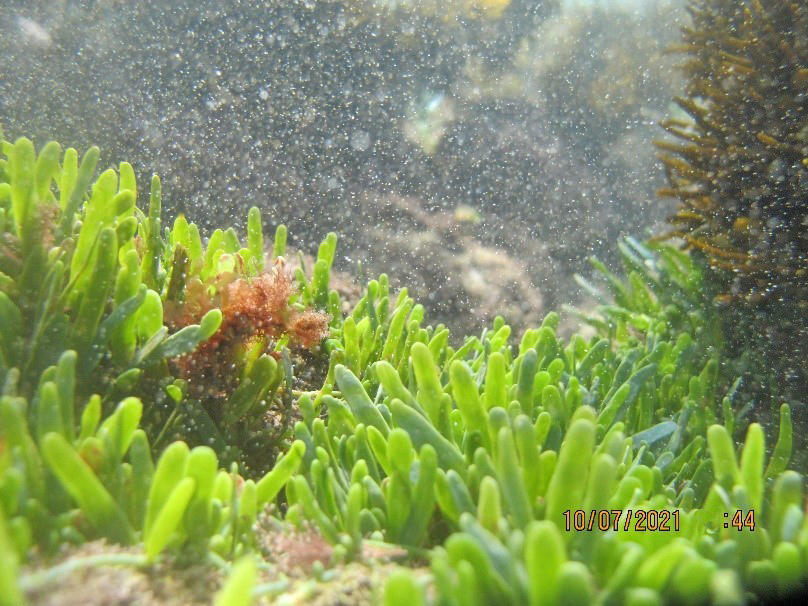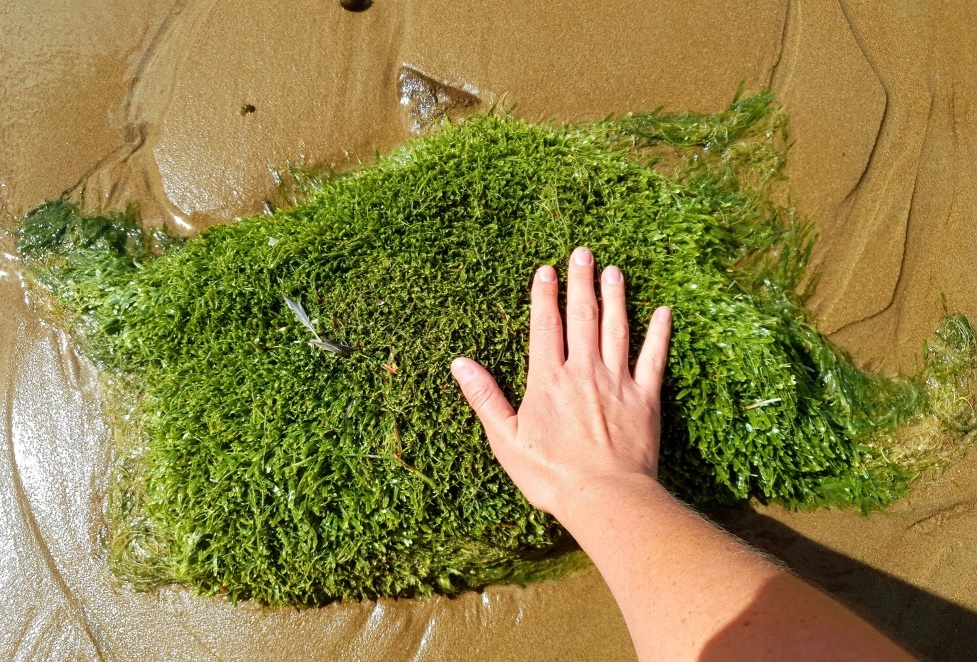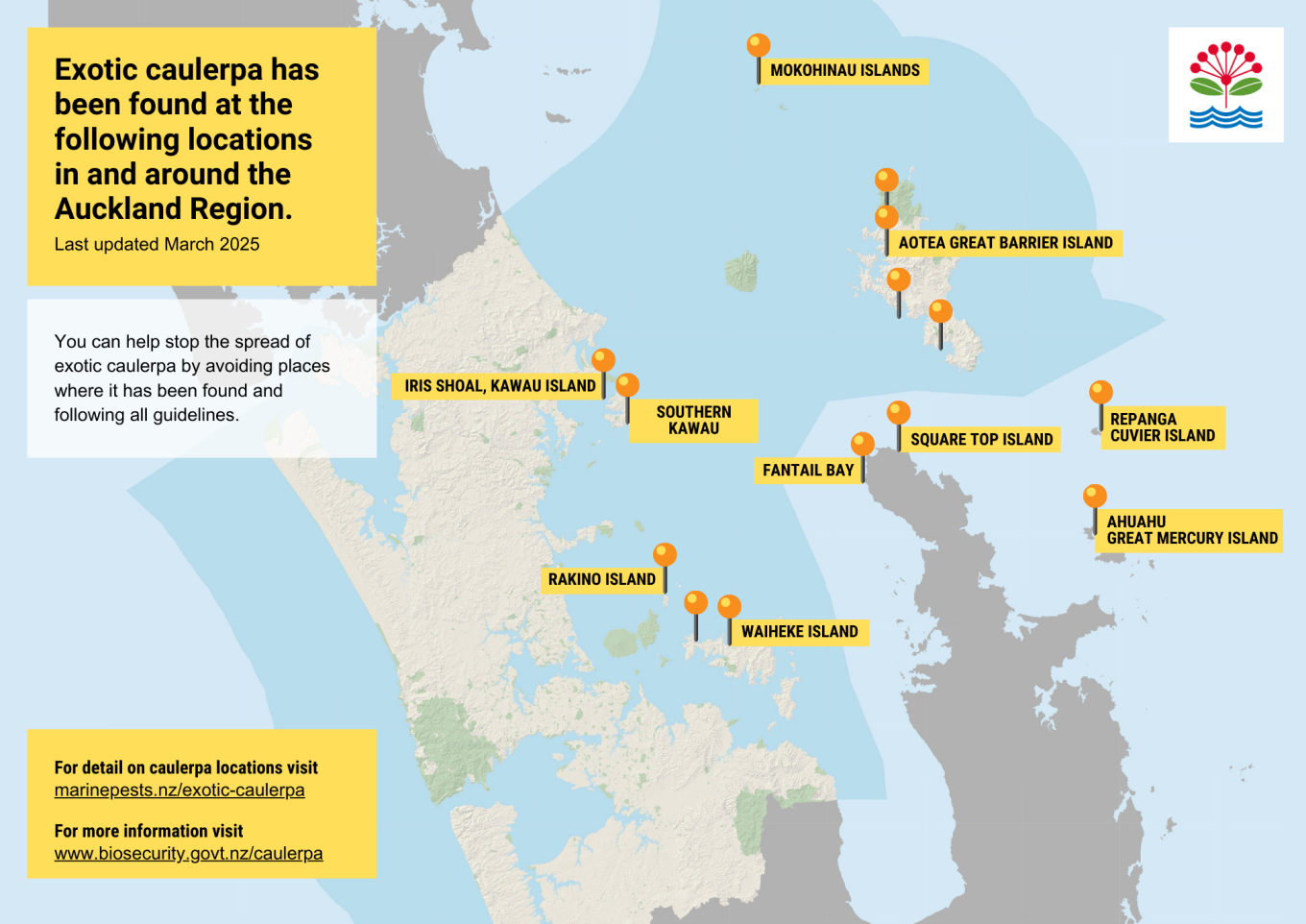Two species of exotic caulerpa seaweed (Caulerpa brachypus and Caulerpa parvifolia) have been found in the North of New Zealand, including in Tāmaki Makaurau Auckland. This invasive marine pest has the potential to seriously harm and transform our coastal environments.
It is critical that all Aucklanders, from boat users to beach goers, understand how to recognise exotic caulerpa, avoid places where we know it's there and know what action to take if it's seen somewhere else.
What does exotic caulerpa look like?
It's important to know what exotic caulerpa looks like so you can recognise it. If you think you see exotic caulerpa, note the location, take a photo and report it to Biosecurity New Zealand on 0800 80 99 66 or online at report.mpi.govt.nz.


Where should I avoid going?
As of October 2023, exotic caulerpa has been found in these Hauraki Gulf Marine Park locations:
- Aotea Great Barrier Island: Blind Bay, Whangaparapara Harbour, Tryphena Harbour and southern Port Fitzroy
- Ahuahu Great Mercury Island: between Ahikopua Point and Maunganui Point
- Kawau Island: Iris Shoal
- Waiheke Island: Onetangi Bay and around Thompsons Point
If you are boating, there is no anchoring and fishing in these areas. In the Auckland region, a Controlled Area Notice (CAN) is in place at Aotea Great Barrier Island, legally restricting some boating and fishing activities. Mana whenua have imposed rāhui in Aotea Great Barrier Island and Waiheke Island with similar restrictions.
If you are out walking on the beach or out on the water, please be vigilant and if you think you see exotic caulerpa, note the location, take a photo and report it to Biosecurity New Zealand on 0800 80 99 66 or online at report.mpi.govt.nz
What is a rāhui and what does it mean?
A rāhui is a Māori principle that restricts or prohibits access to an area or resource to protect the future well-being of the people and natural resources such as the ocean.
In addition to the legal Controlled Area Notices (CANs) in place at Aotea Great Barrier Island and Ahuahu Great Mercury Island, mana whenua have also imposed rāhui in these same areas with the same restrictions.
Ngāti Paoa has imposed a rāhui at Waiheke Island on disturbing the seabed or anchoring within 1 nautical mile (1.8 kilometres) of Thompson’s Point or Onetangi Bay.
Please respect and observe the rāhui.
About the incursions

Aotea Great Barrier
- Exotic caulerpa was first detected in New Zealand at Okupe/Blind Bay by a visiting fisherman and ecologist in 2021. There is an extensive area of exotic caulerpa that extends from Tryphena, into Okupe/Blind Bay and Whangaparapara, and through to the entrance of Port Fitzroy.
- A technique called suction dredging (using a large vacuum cleaner-like machine) to remove the caulerpa was recently trialled at Tryphena and on the smaller incursion at Port Fitzroy. The treated areas will be monitored in the coming months to help understand the effectiveness of the method.
Ahuahu Great Mercury Island
- A smaller area of exotic caulerpa has been found at Ahuahu Great Mercury Island. It does not appear to have spread to the level it has at Aotea Great Barrier.
Iris Shoal, Kawau Island
- Exotic caulerpa was discovered during surveying near Kawau Island in 2023. This is patchy coverage across an 18 hectare area. Hand removal has been attempted by NIWA divers but more investigation is ongoing.
Waiheke Island
- There is an established population, first detected at Onetangi Beach, Waiheke Island, in 2023. This is a popular boating location and a rāhui is in place. Further surveys and control efforts are underway. Like at Aotea Great Barrier Island, iwi and community groups are strongly engaged.
If you find exotic caulerpa outside of these locations – note the location, take a photo and please report it immediately to Biosecurity New Zealand on 0800 80 99 66 or online at report.mpi.govt.nz.
In response to this threat
The Ministry for Primary Industries is leading the response to exotic caulerpa, working closely with iwi, community groups and Auckland Council’s marine biosecurity team in Tāmaki Makaurau.
The elements of the response are:
Surveillance
- Understanding how far exotic caulerpa has spread and detecting new incursions quickly.
Response
- Developing a toolbox to combat exotic caulerpa. This can could include hand removal by qualified divers and for larger incursions, a combination of tools such as suction dredging, benthic mats (mats made from jute, hessian or plastic on the bottom of the seafloor) and treatment using chlorine or salt is possible. Research into the effectiveness of these control methods is ongoing.
Learning
- We have heard from experts in countries that have dealt with exotic caulerpa incursions. Mātauranga Māori is intertwined in this response.
- As we learn more about how to manage exotic caulerpa, it is hoped that we can slow or stop the spread.
- Our goal is to protect our moana while further science and technology solutions are developed and scaled up.
Visit Biosecurity New Zealand for more information.


